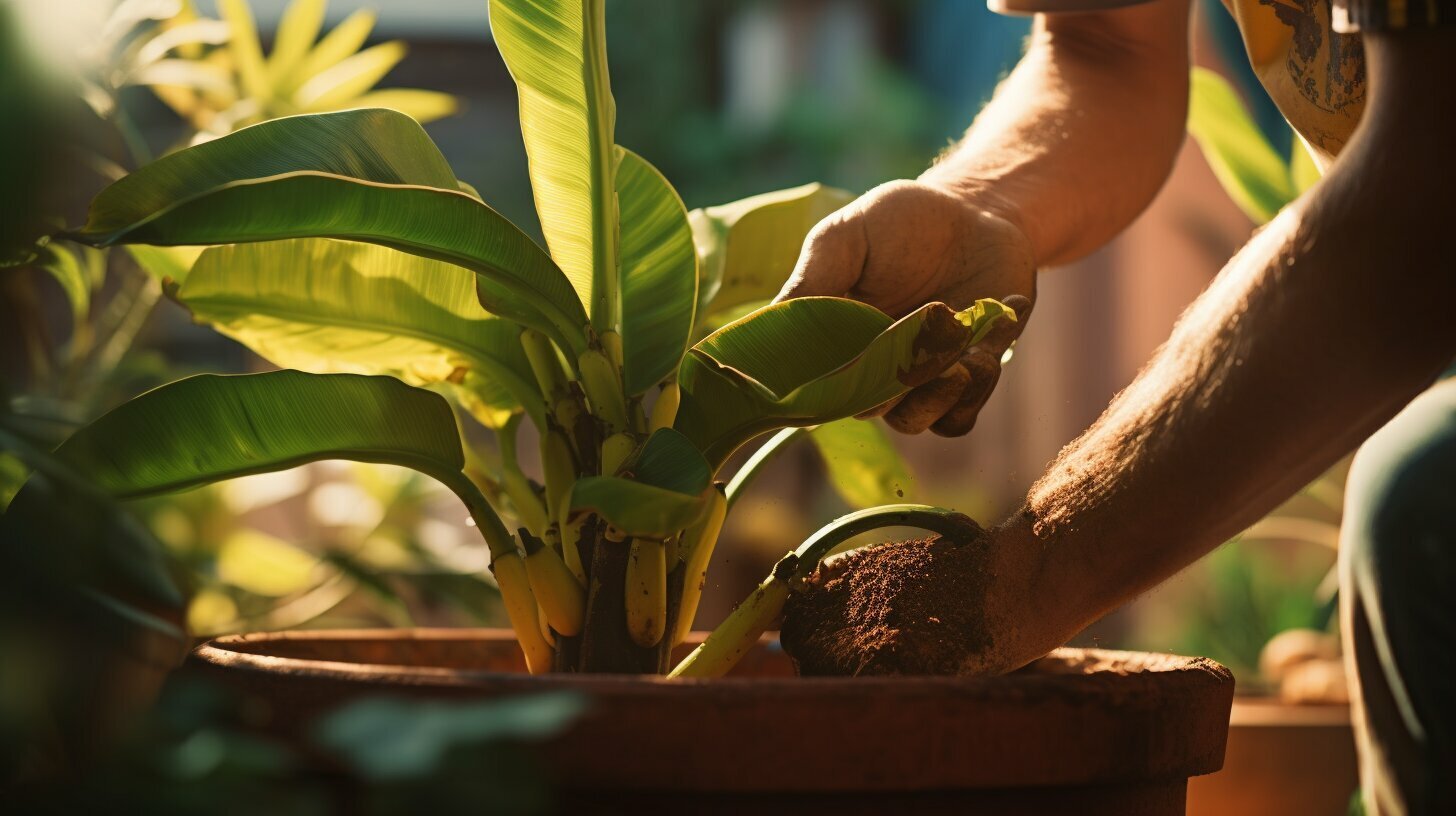Table of Contents
Transplanting a banana tree is an easy and rewarding way to bring a touch of tropical paradise to your garden. By following a few simple steps, you can successfully transplant a banana tree and enjoy its lush foliage and delicious fruit. In this article, I will guide you through the process of choosing the perfect planting location, preparing for transplantation, the step-by-step guide to transplanting, and the essential aftercare needed to maintain and nurture your transplanted banana tree. So, let’s get started and turn your garden into a tropical oasis!
Key Takeaways:
- Transplanting a banana tree can add a tropical flair to your garden.
- Choosing a suitable planting location is crucial for the growth and health of your banana tree.
- Proper preparation before transplantation sets the stage for success.
- Following a step-by-step guide will ensure a smooth and easy transplanting process.
- Aftercare, including regular watering, fertilizing, and pruning, is essential for the continued health and vitality of your transplanted banana tree.
Choosing the Perfect Planting Location for Your Banana Tree
When it comes to planting a banana tree, choosing the right location is crucial for its growth and fruit production. Here are some factors to consider:
- Sunlight: Banana trees thrive in full sunlight, so choose a spot that receives at least six to eight hours of direct sunlight per day. This will ensure optimal growth and fruit production.
- Drainage: Bananas prefer well-draining soil, so avoid areas that are prone to standing water or flooding. Poor drainage can lead to root rot and other problems for your banana tree.
- Wind Protection: Strong winds can damage the leaves and fruit stalks of banana trees. Choose an area that is sheltered from strong winds, such as near a wall or tall plants that can act as natural windbreaks.
- Climate: Banana trees are tropical plants and prefer warm temperatures year-round. If you live in a climate with freezing winters, you’ll need to make arrangements to protect your banana tree during cold weather.
By considering these factors, you can select the perfect location for your banana tree, ensuring it receives the right amount of sunlight, proper drainage, and protection from harsh winds. This will create an optimal environment for your banana tree to thrive and produce delicious fruit.
Choosing the Right Spot for Your Banana Tree
Now that you know what factors to consider when choosing a planting location for your banana tree, let’s dive deeper into each one:
| Factor to Consider | Importance |
|---|---|
| Sunlight | Crucial |
| Drainage | Essential |
| Wind Protection | Important |
| Climate | Significant |
As you can see, each factor plays a vital role in the overall health and success of your banana tree. Take the time to carefully assess your garden or outdoor space to find the ideal spot that meets these requirements.
“Choosing the right location for your banana tree is like finding the perfect vacation spot for relaxation and enjoyment. It’s a place where your banana tree can bask in the warm sunlight, dance with the gentle breeze, and grow to its fullest potential.”
By providing your banana tree with the optimal conditions, you’ll create a paradise for both the tree and yourself. So, take the time to choose the perfect spot and watch your banana tree thrive and bring tropical flair to your garden.
Preparing for Transplantation: Tips and Tricks
Transplanting a banana tree is not as daunting as it may seem, especially when armed with the right knowledge and a bit of preparation. In this section, I will share some handy tips and tricks to ensure a successful transplantation process.
Choosing the Right Time
Timing is crucial when it comes to transplanting a banana tree. It is best to wait until the tree has entered its dormant phase, typically during late fall or winter. This allows the tree to conserve energy and recover more easily from the shock of transplantation. Avoid transplanting during periods of extreme heat or cold, as this can stress the tree further.
Preparing the Planting Site
Before transplanting, it is essential to prepare the planting site properly. Banana trees thrive in well-draining soil with a pH level between 5.5 and 7.0. Ensure that the area receives at least six hours of sunlight per day and is sheltered from strong winds. Clear any weeds or debris from the site, and amend the soil with organic compost to improve its fertility and drainage.
Pruning and Root Preparation
Pruning is a crucial step in preparing a banana tree for transplantation. Trim away any damaged or dead leaves, as well as any excess foliage to encourage healthy growth. When it comes to the roots, gently loosen them from the pot or ground, taking care not to damage them. If the tree is root-bound, gently tease apart the roots to promote outward growth in the new location.
Transplanting Techniques
When transplanting the banana tree, dig a hole that is twice as wide as the root ball and slightly deeper than its current depth. Place the tree carefully into the hole, ensuring that it sits at the same level as it was in its previous location. Backfill the hole with amended soil, gently firming it around the roots to eliminate air pockets. Water the tree thoroughly to settle the soil and provide essential hydration.
Remember, proper aftercare is crucial for the long-term health and success of your transplanted banana tree. Stay tuned for Section 4, where I will provide a step-by-step guide on how to transplant your banana tree, ensuring that you have all the information you need for a seamless transplantation process.
| Tips for Successful Transplantation |
|---|
| Wait for the tree’s dormant phase to transplant |
| Choose a well-draining and sunny planting site |
| Prepare the soil with organic compost |
| Prune damaged and excess foliage before transplanting |
| Gently loosen and tease apart rootbound roots |
| Ensure the tree sits at the same level in the new hole |
| Water thoroughly after transplanting |
“Timing, proper site preparation, pruning, and careful transplanting techniques are key to a successful banana tree transplantation. Follow these tips and tricks to ensure your banana tree thrives in its new home.” – Professional Gardener
Get ready for Section 4, where I will guide you through the step-by-step process of transplanting your banana tree, helping you achieve a successful and stress-free transplantation experience.
Step-by-Step Guide to Transplanting Your Banana Tree
Transplanting a banana tree may seem like a daunting task, but with the right techniques, it can be a smooth and successful process. Here is a step-by-step guide to help you transplant your banana tree with ease.
1.
Choose the Right Time:
Before transplanting your banana tree, it’s crucial to choose the right time. The best time to transplant is during the spring when the soil is warm and moist. This will give your tree the best chance of establishing itself in its new location.
2.
Prepare the New Planting Spot:
Start by preparing the new planting spot for your banana tree. Choose a location that receives plenty of sunlight and has well-draining soil. Dig a hole that is twice as wide as the root ball and slightly deeper than its current depth. You can also add organic compost to the bottom of the hole to provide extra nutrients for growth.
3.
Gently Remove the Banana Tree:
Carefully remove the banana tree from its current location. Start by loosening the soil around the tree with a garden fork or shovel. Be cautious not to damage the roots. Once the soil is loosened, gently lift the tree out of the ground, taking care to keep the root ball intact.
4.
Planting the Banana Tree:
Place the banana tree into the prepared hole in its new location. Make sure the tree is positioned at the same level as it was in its previous spot. Backfill the hole with soil, ensuring that the roots are covered but not overly packed. Lightly press down the soil to provide good contact between the roots and the soil.
5.
Water and Mulch:
After planting, give your banana tree a thorough watering to help settle the soil around the roots. Aim to provide about 2-3 gallons of water. Once the tree is watered, apply a layer of mulch around the base to help retain moisture and suppress weed growth.
Summary:
Transplanting a banana tree can be a simple and rewarding process. Choose the right time, prepare the new planting spot, gently remove the tree from its current location, plant it in its new spot, and provide adequate water and mulch. By following these steps, you can ensure the successful transplantation of your banana tree.
| Benefits of Transplanting a Banana Tree | FAQs when Transplanting a Banana Tree |
|---|---|
| 1. Provides a tropical flair to your garden. | 1. How do you dig up a small banana tree? |
| 2. Allows for optimal growth and health of the tree. | 2. Can you transplant a banana tree in the summer? |
| 3. Gives you the opportunity to choose the perfect planting location. | 3. How long does it take for a transplanted banana tree to bear fruit? |
Transplanting a banana tree takes patience and preparation, but the end result of your hard work will leave you with beautiful foliage in no time at all. With our guide on how best to prepare, transplant, and care for your new addition – plus what benefits come from doing so – we’ll help make sure that when it comes time to transplant your beloved banana tree, everything goes smoothly.
In conclusion, by following these step-by-step instructions and considering the benefits of transplanting a banana tree, you can successfully move your tree to a new location and ensure its continued growth and vitality. Happy transplanting!
Aftercare: Maintaining and Nurturing Your Transplanted Banana Tree
After successfully transplanting your banana tree, the work doesn’t end there. To ensure the continued growth and health of your banana tree, proper aftercare is essential. Here are some tips to help you maintain and nurture your transplanted banana tree:
1. Watering: Adequate watering is crucial for the survival of your banana tree. While banana trees require regular watering, be careful not to overwater them as it can cause root rot. Aim to water your banana tree once every two weeks, or when the top inch of soil feels dry. This will help maintain proper moisture levels without saturating the roots. Remember, banana trees prefer well-draining soil, so ensure that water doesn’t accumulate around the base of the tree.
2. Fertilizing: Providing your banana tree with the right nutrients is essential for its growth and fruit production. Use organic fertilizers, such as fish emulsion or seaweed extract, during the active growing seasons. Follow the instructions on the package for proper application. Fertilize your banana tree monthly to promote lush foliage production and ensure healthy fruit development.
3. Pruning: Regular pruning is necessary to maintain the appearance and health of your banana tree. Remove any dead fronds or damaged stems periodically throughout the year to keep the overall shape neat and tidy. This will also encourage further branching outwards from the main trunk structure, promoting a fuller and more robust tree.
Remember to always use clean and sterilized pruning shears or scissors to prevent the spread of diseases or infections. Make clean cuts at an angle to promote faster healing and prevent water accumulation on the cut surface.
With proper aftercare, your transplanted banana tree will thrive and reward you with beautiful foliage and, eventually, delicious bananas. Stay consistent with watering, fertilizing, and pruning, keeping an eye out for any signs of stress or disease. By nurturing your banana tree, you’ll continue to enjoy its tropical flair in your garden for years to come.







